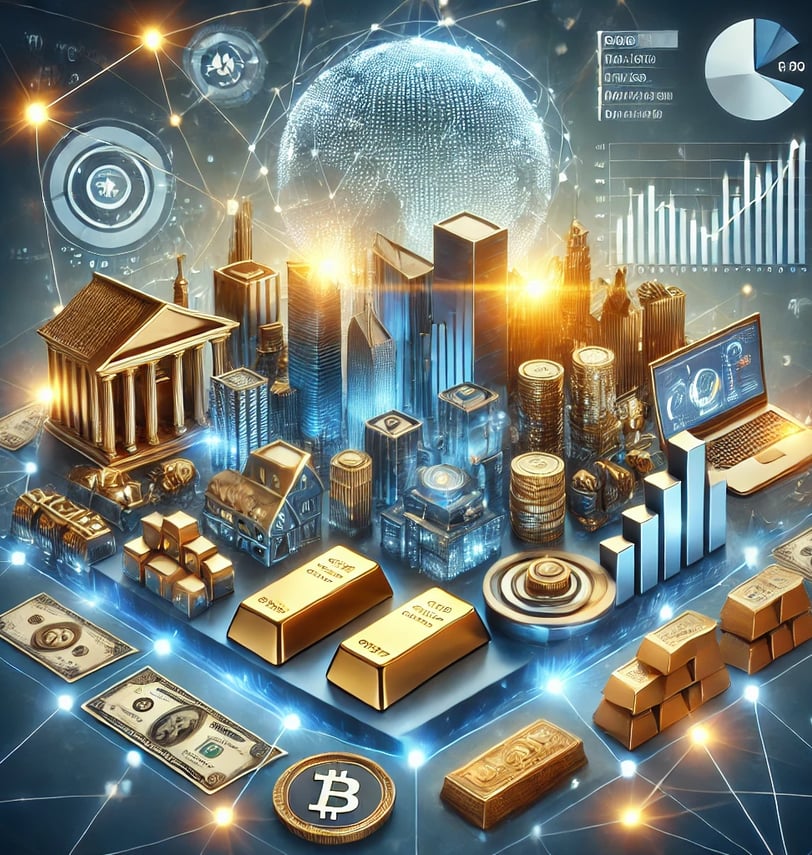Real World Assets (RWA) in the Cryptocurrency World: Transforming Real-World Assets into Digital Tokens
CRYPTO MARKET
2/6/20253 min read


The cryptocurrency universe has been rapidly evolving, expanding beyond traditional digital currencies and purely virtual assets. One of the most promising innovations in this ecosystem is the tokenization of real-world assets, known as Real World Assets (RWA). This concept aims to transform tangible assets such as real estate, commodities, financial securities, and even artworks into digital tokens recorded on blockchains. This article explores the RWA segment, its utilities and applications, the main crypto assets involved, and the potential valuation of this trend in the market.
What are Real World Assets (RWA)?
Real World Assets refer to tangible or financial assets from the real world that are digitized and recorded on the blockchain through tokenization. Tokenization consists of converting rights over a physical or financial asset into digital tokens, which can be traded in a fractional and transparent manner on decentralized networks.
RWA can include:
Real Estate: Tokenized properties allow investors to acquire fractions of a property, democratizing access to the real estate sector.
Commodities: Gold, silver, and other precious metals can be digitally represented, allowing liquidity and simplified trading.
Financial Securities: Bonds, stocks, and debentures can be issued as tokens, expanding the accessibility of financial markets.
Artworks and Collectibles: Physical art pieces can be tokenized, enabling participation from investors who otherwise could not acquire an entire piece.
Utility and Real-World Applications
The tokenization of real-world assets provides several benefits, including:
Accessibility and Financial Inclusion
The ability to acquire fractions of assets allows small investors to access markets previously restricted to large institutional players.
Enhanced Liquidity
Assets such as real estate and commodities, traditionally less liquid, can be traded quickly and easily on decentralized platforms.
Transparency and Security
Blockchain registration ensures immutability and traceability of transactions, reducing fraud risks and increasing investor confidence.
Efficiency and Cost Reduction
Eliminating traditional intermediaries (banks, registries, brokers) reduces operational costs and increases transaction efficiency.
Integration with Decentralized Finance (DeFi)
Tokenized assets can be used as collateral in DeFi protocols, expanding loan opportunities and passive income generation.
Main Projects and Crypto Assets Involved
Several projects and platforms are leading the movement to tokenize real-world assets. Among the main crypto assets and protocols in this sector, the following stand out:
MakerDAO (MKR): A pioneer in integrating RWA into the DeFi sector, allowing real assets to be used as collateral for issuing the DAI stablecoin.
Centrifuge (CFG): A platform dedicated to tokenizing financial assets, connecting businesses to decentralized financing.
RealT (REALT): Specializing in real estate tokenization in the United States, enabling the purchase of property fractions.
Ondo Finance (ONDO): Focused on issuing tokenized assets that represent traditional investments such as government bonds and structured funds.
Goldfinch (GFI): A platform facilitating credit issuance to real-world businesses using RWA as collateral.
Synthetix (SNX): Enables the creation of synthetic assets, digitally representing real-world goods.
Pendle (PENDLE): A protocol that allows the separation of yield and principal from tokenized assets, offering new investment strategies.
Realio Network (RIO): A platform focused on the tokenization and trading of real-world assets, including real estate and private investments.
Potential for Valuation
The RWA market has enormous growth potential as more economic sectors adopt tokenization. Some factors driving this valuation include:
Growth of the DeFi Sector: The integration of real assets expands DeFi market possibilities, attracting more capital and institutional investors.
Favorable Regulation: Advancements in digital asset regulation can boost RWA adoption and increase market participant confidence.
Institutional Adoption: Major companies and banks are exploring tokenization as an efficient way to manage assets and reduce operational costs.
Expansion of the Digital Economy: With the increasing digitization of the financial sector, demand for tokenized assets is expected to rise, driving the value of the projects involved.
Challenges and Considerations
Despite its great potential, the RWA segment faces significant challenges, such as:
Regulation and Compliance: Different jurisdictions have varying rules on asset tokenization, which can hinder large-scale adoption.
Technological Infrastructure: Interoperability between different blockchains and traditional systems still needs improvement.
Security and Governance: Ensuring that tokenized assets are indeed backed by real goods and preventing fraud are ongoing challenges.
The Real World Assets (RWA) market represents one of the most promising applications of blockchain technology, enabling the digitization and democratization of access to real-world assets. With benefits such as increased liquidity, transparency, and accessibility, RWA is gradually reshaping sectors such as real estate, finance, and commodities. However, challenges such as regulation and security still need to be overcome for this trend to reach its full potential.
Disclaimer
This article is for informational and educational purposes only and does not constitute investment advice. Before making any financial decisions, it is recommended to consult a qualified professional and conduct a thorough risk analysis.
